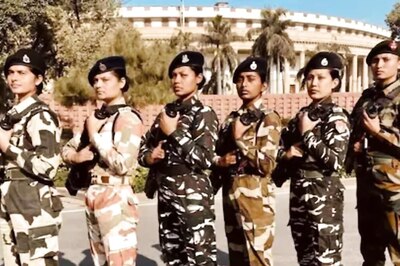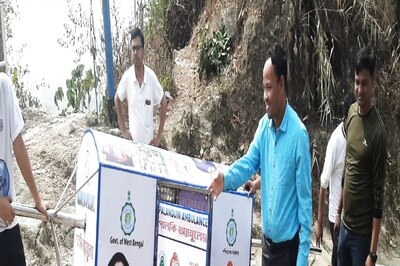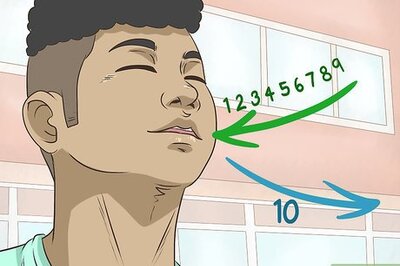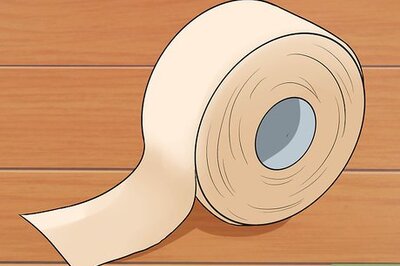
views
New Delhi: In its 1,045-page judgment on the Ayodhya title dispute on Saturday, the Supreme Court, broadly speaking, relied on four facts to give a go-ahead to the construction of Ram Mandir on the 2.77-acre disputed site.
To summarise, these points are:
1. The Muslim parties could not produce a record of ownership for the 300 years after the construction of the mosque in 1528, during which period it also could not furnish any evidence that Muslims offered ‘namaz’ in that mosque.
2. Travelogues, mainly written by Father Joseph Tieffenthaler and Montgomery Martin, gave detailed accounts of “faith and belief of the Hindus” based on the “sanctity which they ascribed to the place of birth of Lord Ram and of the actual worship by the Hindus at the Janmasthan”.
3. The survey report of the Archaeological Survey of India (ASI) indicated a “pre-existing underlying structure dating back to the 12th century” and in its findings it indicated that “the underlying structure” was of Hindu origin.
4. The Hindu parties had provided enough evidence, in the form of various oral testimonies and travellers’ remarks, to show that even during the existence of the mosque Hindus had laid strong claim to both the inner and outer courtyard of the disputed site.
“The existence of an Islamic structure at a place considered sacrosanct by the Hindus did not stop them from continuing their worship at the disputed site and within the precincts of the structure prior to the incidents of 1856-57,” observed the court.
This is why the five-judge bench said, “The Hindus have established a clear case of a possessory title to the outside courtyard by virtue of long, continued and unimpeded worship at the Ram ‘chabutra’ and other objects of religious significance,” and ruled in their favour.
However, while making these observations, the court also noted that the placing of the idols in the mosque in 1949 was a “serious violation of law”, calling it a “desecration”. It noted that there was “no evidence to establish that the Muslims abandoned the mosque or ceased to perform ‘namaz’ in spite of the contestation over their possession of the inner courtyard after 1858”.
And, finally, that “during the pendency of the suits, the entire structure of the mosque was brought down in a calculated act of destroying a place of public worship. The Muslims have been wrongly deprived of a mosque which had been constructed well over 450 years ago”, the bench observed.
‘No record of ownership’
On the first point, of the Sunni Waqf Board being unable to provide enough evidence of continuous use, the Supreme Court elaborates: “Though, the case of the plaintiffs…is that the mosque was constructed in 1528 by or at the behest of Babur, there is no account by them of possession, use or offer of namaz in the mosque between the date of construction and 1856-7. For a period of over 325 years, which elapsed since the date of the construction of the mosque until the setting up of a grill-brick wall by the British, the Muslims have not adduced evidence to establish the exercise of possessory control over the disputed site. Nor is there any account in the evidence of the offering of namaz in the mosque, over this period.”
‘Detailed accounts of Ram’s worship’
The Constitution bench then speaks about the evidence in favour of the Hindu side being provided by travellers.
“William Finch (1608-1611) and Tieffenthaler, who visited India between 1743 and 1785, provided an account of Ayodhya. Conspicuous in both the accounts are references to worship by the Hindus to Lord Ram. The positive account of Hindu worship to Lord Ram is of probative value.”
“Tieffenthaler specifically refers to Hindu places of worship including Sita Rasoi, Swargdwar and the Bedi or cradle symbolising the birth of Lord Ram. The account refers to religious festivals where during the course of which Hindu devotees would throng for worship. Tieffenthaler‘s account in the 18th century is prior to the construction of the grill-brick wall in front of the mosque. Tieffenthaler refers to -- a square box raised five inches above the ground with borders made of lime with the length of more than five ells and the maximum width of four ells, which the Hindus called the Bedi or cradle. This, as he notes, was the site of the house where Lord Vishnu was born in the form of the Lord Ram. This, as he notes, is where it was believed that either Aurangzeb or (according to others) Babur got the place razed.”
(An ell is the length of a forearm and extended hand, also known as cubit.)
ASI report on structure
The bench takes into account key findings of the ASI team, some of which are:
(i) The pre-existing structure dates back to the 12th century; and
(ii) The underlying structure, which provided the foundations of the mosque together with its architectural features and recoveries, are suggestive of a Hindu religious origin comparable to temple excavations in the region and pertaining to the era.
Oral testimonies of Hindu parties
The Supreme Court notes: “The evidence indicates that despite the existence of a mosque at the site, Hindu worship at the place believed to be the birthplace of Lord Ram was not restricted. The existence of an Islamic structure at a place considered sacrosanct by the Hindus did not stop them from continuing their worship at the disputed site and within the precincts of the structure prior to the incidents of 1856-57. The physical structure of an Islamic mosque did not shake the faith and belief of Hindus that Lord Ram was born at the disputed site. Hindu worship at Ramchabutra, Sita Rasoi and at other religious places including the setting up of a Bhandar clearly indicated their open, exclusive and unimpeded possession of the outer courtyard. The Muslims have not been in possession of the outer courtyard.”
It goes on to state: “Testimonies of both Hindu and Muslim witnesses indicate that on religious occasions and festivals such as Ram Navami, Sawan Jhoola, Kartik Poornima, Parikrama Mela and Ram Vivah, large congregations of Hindu devotees visited the disputed premises for darshan. The oral testimony of the Hindu devotees establishes the pattern of worship and prayer at Sita Rasoi, Ramchabutra and towards the Garb Grih‘, while standing at the railing of the structure of the brick wall.”




















Comments
0 comment